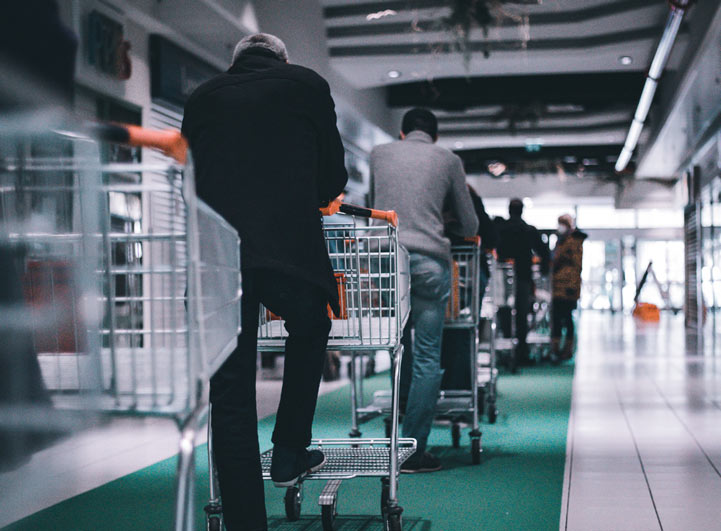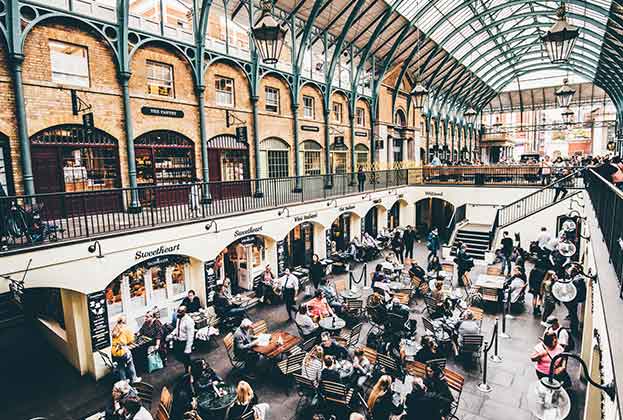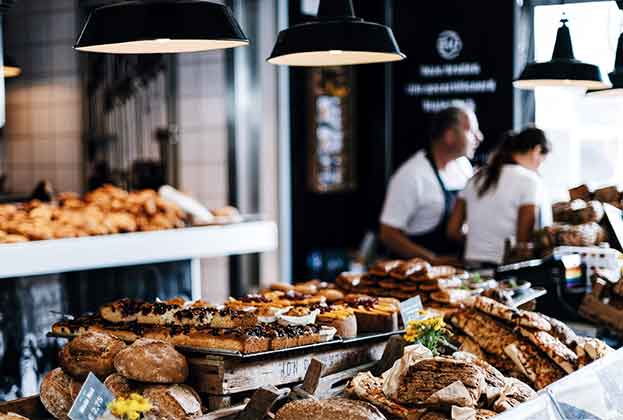The lockdown measures taken to prevent the spread of Covid-19 have had a profound impact on consumer behaviour
Consumer confidence
Eurozone GDP dropped by a post-war record of 12.1% Q/Q in Q2, reducing the economy to the size it was at 15 years ago. The scale of the contraction varied between countries. GDP fell by 10.1% QoQ in Germany and as much as 18.5% in Spain – a difference that is primarily explained by the duration and strictness of the national lockdowns. Output began to recover in May and June. The pace of the rebound will undoubtedly slow as the economy gets closer to a ‘normal’ level. But July’s final PMIs suggest that activity continued to pick up throughout the eurozone at the start of Q3, even if the recovery appears to have been slower in the likes of Italy and Spain, which are being held back by their struggling tourism sectors (Capital Economics).
Some of the high-frequency data show that activity has got back to its pre-crisis level. Visits to leisure and retail locations are nearly back to normal in the larger economies. Despite the V-shaped recovery in retail sales, Capital Economics expects eurozone consumption to recover more gradually and remain below pre-crisis levels for the rest of the year. The 0.7% increase in retail sales in July left it just above its pre-crisis level. This recovery was boosted by strong online sales. Food sales increased by 1.1%, electrical goods and furniture by 5.6%, while fashion was still -23.7% down YoY.
But the recovery in consumer confidence slowed in July. Consumers indicated that they are reluctant to spend on major purchases and plan to save more both currently and over the next 12 months (Capital Economics). As a result, total consumer spending is likely to remain weak for a long time yet. Amongst the countries with consumer confidence gains in July were Poland (5.1 pts), UK (4.4 pts) and Ireland (3.2 pts). Some of the more pessimistic consumers were found in Greece (-7.0 pts), Belgium (-2.7), Portugal (-2.1) and Italy (-1.8).
Positive sentiment may not be long-lived as government support programs are gradually coming to an end and consumers feel uncertain about their future employment. Eurozone employment fell sharply in Q2, as many firms have reduced their staff number by not renewing fixed-term contracts, but the drop would have been much bigger in the absence of short-time work schemes. The unemployment rate rose to 7.8% in June from 7.2% in Q1.
Spain's unemployment rate increased to 15.3% in the second quarter of 2020, the highest since the first quarter of 2018, but below market expectations of 16.7% given the pick-up in hiring in the tourism sector. As a percentage of employment in mid-March, furloughed workers peaked at 23.7% in late April, and still accounted for 17% at end-June.
In the Netherlands, unemployment has risen to 404,000 people (4.3% of the total workforce), compared to 273,000 people in March (2.9%). In Portugal, the provisional estimate of the unemployment rate in June was 7.0%, reflecting an increase of 21.1% (61,300) of the unemployed population in relation to the previous month. Significant rises in the number of unemployed in June compared to the previous month were also noted in the Czech Republic (10%), Sweden (9%), Italy (7%) and Denmark (7%). In the UK, a reported ¾ million jobs have been lost since March, but the ONS acknowledges that with furlough schemes in place, the picture is difficult to track, with other analysis indicating that the unemployment rate remains essentially unchanged since before the outbreak began.
Footfall
Footfall has been slowly recovering over the weeks since reopening of the retail and leisure sector. ShopperTrak retail traffic data shows that in August retail footfall had recovered substantially in Europe, but was still markedly lower than last year: around -25% in France, -30% in Germany and Italy and -40% in the UK, Spain and the Benelux. However, it is important to note that some of the differences in recovery are related to different reopening schedules.
In most countries activity normalised faster in open-air and convenience retail formats, such as retail parks and neighbourhood high street locations. Especially regarding retail parks, outdoor parking, large and open spaces, which allow for social distancing, and focus of retail mix on convenience goods have offered more confidence to customers with regards to safety and comfort.
In the UK, retail park footfall has recovered to -20% YoY, compared to the national average of -40% YoY. Savills has observed the retail park format to also be showing greater resilience in Spain and is expected to gain prominence in the next few years, through improved professional asset management. Additionally, the factory outlet format could also play an important role, especially in releasing the surplus stock accumulated during the closing period, and certain brands could have pop-up spaces to release their products.
In Germany, the number of visitors to specialist retail parks, in particular, has almost completely recovered. Nationwide, only 7% fewer people were on the move there in the week from 15 to 21 June than before the pandemic; three weeks earlier the difference was only 4%. The resilience of this format is beginning to impact retailer strategies. There are examples of essential good retailers, who are shifting their expansion plans from city to retail warehouse locations.
In France, large-scale retail formats experienced a peak of footfall during the first days of the lockdown, due to stockpiling, but later, supermarket and hypermarket footfall dropped. Travel limitations, crowd-phobia and hygienic concerns have kept people away from stores and shifted to online orders, drive-through and home delivery services. The situation seems to be improving since the release from the lockdown, but returning to normal still has a long way to go for large-scale retail formats.
Shopping centre formats have suffered the most during the health crisis, as social distancing regulations have not allowed the reopening of entertainment venues, and consumers have been avoiding indoor retail destinations. Footfall indices in France confirm that, while customer flows have been on the rise in May and June, they are still far behind the pre-crisis situation (close to 80%). According to Polish Shopping Centre Council, data footfall in shopping centres in Poland stands at over 70% of last year's levels. The figures in German shopping centres are continuing to rise and are approaching pre-crisis levels again (-19%), albeit at a much slower pace than retail parks.
The situation on the high street is mixed. The implications have been more severe for tourist destinations such as key high streets in Paris, London, Madrid, Barcelona and Milan, where the turnover is closely dependent on foreign tourist consumption. Under the current conditions, both the big luxury brands and mass-market brands are likely to reach their clientele through online channels, maintaining the flagship stores that have invested in over the recent years, until the situation normalises.
In high street retail locations in the Netherlands, footfall was 50% lower in June 2020 compared to June 2019, and has remained on that level since May. While London city centre recovery has remained muted in the UK, on the other hand, rural city centre footfall has recovered much faster supported by local community shopping. UK rural and commuter towns were the first to reach 75% pre-Covid mobility, following the reopening of the leisure sector. In Germany, city centre mobility was also just 16% below pre-lockdown levels, with smaller cities generally recovering faster.
Retail sales
While retail sales have been greatly affected by business closures during the lockdown, there is a significant variation in performance for different goods categories. The sectors that were affected the most were Clothing and Footwear, while smaller drops or even gains were noted in Sports, Electronics, DIY, Furniture and Homeware, as people had the opportunity to spend more time on hobbies and home improvements during the lockdown. Fashion spend was down about -30% YoY in the UK (July), -39.2% in Spain (June), while the Netherlands and Portugal suffered a -57.7% and -50% YoY drop in April respectively. Food and grocery sales were up annually across all markets, 11% in the UK, 15.2% in Spain, 10% in the Netherlands over the same months. This is largely attributed to lockdown resulting in all meals being taken in the home, rather than a high proportion being spent in restaurants, cafés and takeaways.
Retail sales have bounced back strongly following the gradual reopening of nonessential stores across Europe; in most countries, they are at, or even above, pre-lockdown levels. However, the situation is not homogeneous across countries or sectors.
In France, according to INSEE, household spending is already returning to normal, with expenditure in June 4% above February levels. This could be partly attributed to the accumulation of savings during the lockdown, estimated at €75bn. Fashion expenditure has caught up since the end of the lockdown, while Food and Electronics expenditure is already above pre-crisis levels, as people still choose to spend more time at home. Conversely, spending in Hospitality and Bars & Restaurants is still lagging behind, due to a sharp drop in foreign tourist visits.
Similarly, in Ireland, household deposits increased dramatically by €6.2bn between April and June, curtailing and spending opportunities. This pent-up demand is now being unleashed, since reopening with retail sales bouncing back strongly in June, by 3.6% pa.
In Portugal, despite an increase in foot traffic, this has not yet been reflected in an increase in sales. According to the Association of Retail and Catering Brands (AMRR) between the 15th and the 21st of June, in the Lisbon region, high street stores and shopping centres reported a 40.1% drop in sales, a figure that rises to 42.5% in the rest of the country, to a national average of 41.3%. In Germany, retail turnover was up 4.2% YoY in July, with some discrepancies amongst sectors, Fashion was still down -8%, while grocery sales were up 4.6% YoY.
In general, despite footfall being down significantly year-on-year, it appears that spending has not dropped at the same rate. Shoppers are visiting with defined missions – not only are they making fewer visits, they are shopping at fewer stores per trip, but conversion rates and basket sizes are up. There have been high levels of conversion with consumers ‘mission shopping’ rather than browsing.
Social distancing measures and other safety restrictions will remain in place in some form or another for the rest of the year, and at least the first quarter of 2021, hampering physical retail sales. While retail will recover in 2021, it is not expected to return to 2019 levels due to high unemployment, and consumer uncertainty regarding their financial futures. Retailers, especially in the fashion sector, are reacting with discounts, online promotions, and many are planning the introduction of cheaper collections in order to adapt to weaker spending patterns.

E-COMMERCE TRENDS
E-commerce surged across Europe during the lockdown, as it became the safest way of shopping and the only channel for buying non-essential goods. Confined consumers used the online channel to buy groceries, pharmaceuticals, but also electronics, books, sports equipment, clothing and takeaway meals. A larger share of the population has discovered the ease and the benefits of online shopping and all retailers were forced to improve their e-commerce platforms. On the other hand, in less developed digital markets, the explosion of online sales has led to longer delivery times, impacting consumer trust in online retail reliability.
The digital disruption has been transforming retail well before the health crisis. Online retail penetration had increased in Europe from 7% to close to 12%, between 2014 and 2019 (Forrester, 17 countries). CRR estimates that online sales in the UK, Germany, France, Spain, Italy and the Netherlands will be close to €325bn, a rise of 31% YoY pushing up their average share of total retail sales to 16.2% (skewed by the size of the UK market). However, CRR estimates that under the impact of the economic crisis and reduced consumer spending, online sales will dip in 2021 to about €312bn before the anticipated 2022 recovery and higher growth rate of e-commerce.
In the UK, e-commerce reached 31.2% of total retail sales (ONS), compared to an average of 19.1% for the whole of 2019. Early indications suggest that the peak seen in May is now settling to a new level. The question is, 'Where to?' CRR forecasts 24.3% at the end of 2021, which fits with our own analysis. If true, then this sees a five-year acceleration in the move online.
Turnover growth of online YoY in the Netherlands. However, in April 2020, turnover of online sales has increased by 68% compared to April 2019. Thereafter in May 2020, online sales increased by 50% compared to May 2019, as shops reopened again. We expect the growth of online sales to increase somewhat although the degree to which it will change remains to be seen.
In Spain, according to Minsait, online sales in sectors such as Food, Sports, Personal care and School supplies have grown by 80% to 200% during the lockdown and are expected to expand further. We estimate that the market share of online commerce, as opposed to the physical channel, will be close to 10% in 2020, which implies an increase in sales of 27% in relation to 2019.
In Portugal, SIBS announced that the average value of online purchases increased by approximately 18% over the confinement period. A study carried out by Group M in April, notes that e-commerce growth in food retail was between 40% and 60%. In 2019, the share of online retail sales was at 9.8%.
In Sweden, retail sales increased by 44% YoY in April, with the highest rises noted in the categories of Health and Beauty (48%), Fashion (40%), Books (34%), Electronics (21%) and Food (21%). In Germany, e-commerce increased by 9.2% in the first half of the year, while in France, its share has crossed the threshold of 10%.
While footfall has begun to slowly recover and people are gradually returning to physical stores, the latest figures in the UK show little abatement in the inexorable rise of online grocery shopping. Online sales for the period soared 92%, with one in five UK households having utilised the channel in some form to buy groceries. Online is now worth 13% of the total grocery market, up from just 7.4% in March when lockdown began.
Read the articles within Spotlight: Impact of Covid-19 on European retail below.
.jpg)


